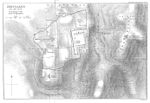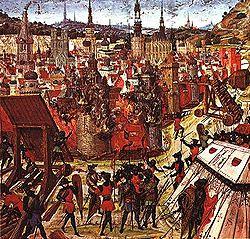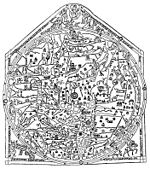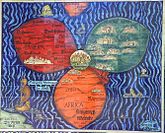- History of Jerusalem (Middle Ages)
-
Main article: History of JerusalemSee also: Kingdom of Jerusalem
The history of the city of Jerusalem in the Middle Ages takes it from the 10th century when it was under the rule of the Fatimid caliphate, to the Crusades and shifts in control brought by the Europeans, until the city was re-taken by the Khawarazmi Turks in 1244. The city then stayed under Muslim control for the next several hundred years. It was passed back and forth through various Muslim factions until decidedly conquered by the Ottomans in 1517, who maintained control until the British took it in 1917.
Contents
Byzantine rule
Jerusalem reached a peak in size and population at the end of the Second Temple Period: The city covered two square kilometers (0.8 sq mi.) and had a population of 200,000.[1][2] In the five centuries following the Bar Kokhba revolt in the 2nd century, the city remained under Roman then Byzantine rule. During the 4th century, the Roman Emperor Constantine I constructed Christian sites in Jerusalem such as the Church of the Holy Sepulchre. From the days of Constantine until the Arab conquest in 638, despite intensive lobbying by Judeo-Byzantines, Jews were forbidden to enter the city.
The expansion of Islam started with the life of Muhammad (570-632), and Islamic culture spread rapidly from Saudi Arabia into neighboring territories such as Palestine. Following the Arab capture of Jerusalem, the Jews were allowed back into the city by Muslim rulers such as Umar ibn al-Khattab.[3]
In the four hundred years that followed, Jerusalem's prominence diminished as Arab powers in the region jockeyed for control.[4]
Arab Caliphates (638-1300s)
See also: Islamization of Palestine Map of Jerusalem as it appeared in the years 958-1052, according to Arab geographers such as al-Muqaddasi.
Map of Jerusalem as it appeared in the years 958-1052, according to Arab geographers such as al-Muqaddasi.
The city was one of the Arab Caliphate's first conquests in AD 638. According to Arab historians of the time, the Caliph Umar ibn al-Khattab personally went to the city to receive its submission, slaughtered the garrison and population who had fled to the citadel, and oversaw its cleaning out. Sixty years later, the Umayyad Dynasty caliph Abd al-Malik commissioned and completed the construction of the Dome of the Rock over the Foundation Stone on Jerusalem's Temple Mount.[5] Although the Qur'an does not mention the name "Jerusalem", the hadith specify that it was from Jerusalem that Muhammad ascended to heaven in the Night Journey, or Isra and Miraj. Al-Malik built the octagonal and gold-sheeted Dome over the location from which Muhammad was believed to have ascended into heaven. The Al-Aqsa Mosque (named for the "farthest mosque") was also built nearby, again in honor of the story of the Night Journey.
Under the early centuries of Muslim rule, especially during the Umayyad (650-750) and Abbasid (750-969) dynasties, the city prospered; the 10th century geographers Ibn Hawqal and al-Istakhri describe it as "the most fertile province of Palestine", while its native son geographer al-Muqaddasi (born 946) devoted many pages to its praises in his most famous work, The Best Divisions in the Knowledge of the Climes. Jerusalem under Muslim rule did not achieve the political or cultural status enjoyed by the capitals Damascus, Baghdad, Cairo etc.
Although they were severely discriminated and regulated in worship, movement, ownership of property, reparing of buildings etc., the early Arab period tolerated the presence of Christian and Jewish communities in the city with the Jewish population given the most freedom and benefices. However, the communities, especially the Christians were in essence second class citizens, forbidden to proslytize, worship outside of specific locations, limited in areas where they could travel, forced to bow before Muslim Mosques and Imams, charged to wear specific clothing, ordered to make way on the streets to Muslims, and limited in the number of pilgrims allowed to visit Holy sites. The Emperor Charlamagne started the precedent of Western European influence in the region under various treaties with the Caliphs establishing Frankish protection for pilgrims.
With the decline of the Carolonian Empire in the early 10th century, another period of persecution by the Muslims began. However, the recovered Byzantines filled this void and as the Empire expanded under the Byzantine Crusades, Christians were again allowed to pilgrimage to Jerusalem.
According to Rabbi Elijah of Chelm, German Jews lived in Jerusalem during the 11th century. The story is told that a German-speaking Palestinian Jew saved the life of a young German man surnamed Dolberger. So when the knights of the First Crusade came to besiege Jerusalem, one of Dolberger’s family members who was among them rescued Jews in Palestine and carried them back to Worms to repay the favor.[6] Further evidence of German communities in the holy city comes in the form of halakic questions sent from Germany to Jerusalem during the second half of the 11th century.[7]
As the Byzantine borders expanded into the Levant in the early 11th century, the limited tolerance of the Muslim rulers toward Christians in the Middle East, began to wane. The Egyptian Fatimid Caliph Al-Hakim bi-Amr Allah ordered the destruction of all churches throughout Al-Islam starting with the churches in Jerusalem. The Church of the Holy Sepulchre, revered by most Christians as the site of Christ's crucifixion and burial, was among the places of worship destroyed, but permission was later given for its rebuilding.
In 1070-71, the Turkic emir Atsiz ibn Uvaq al-Khwarizmi besieged and captured the city, placing it under the nominal control of the 'Abbasid caliphate. In 1077, on his return from a disastrous attempt to capture Cairo, the capital of the Fatimid caliphate, he found that in his absence the inhabitants of Jerusalem had rebelled and forced his garrison to shelter in the citadel. He therefore besieged the city again, and on recapturing it, slaughtered an estimated 3,000 of the rebel inhabitants, including those who had taken shelter in the Al-Aqsa mosque. In 1079, Atsiz was murdered by his nominal ally Tutush, who subsequently established firmer 'Abbasid authority in the area. A new period of turbulence began in 1091 with the death of Tutush's governor in Jerusalem, Artuq and the succession of his two sons, who were bitter rivals. The city changed hands between them several times, until in 1098 the Fatimids, seizing the opportunity presented by the approach of the first Crusade, regained control.[8]
Crusader control
History Timeline · 1000 BC · 721 BC · 597 BC
587 BC · Second Temple Period · 70
614 · 637 · Middle Ages · 1099
1187 · 1244 · 1917 · 1947 · 1948Religious significance Judaism · Christianity · Islam
Temple Mount · Western Wall
Dome of the Rock · al-Aqsa Mosque
Holy Sepulchre ChurchDemographics · People Names · Positions Places Old City · Archaeological sites
Synagogues · Churches · Mosques
Neighbourhoods · Mountains
East JerusalemOther topics Mayors · Flag · Emblem
Jerusalem Law
Jerusalem Day · Quds Day
Transportation · EducationReports of the renewed killing of Christian pilgrims, and the defeat of Byzantium by the Seljuqs, led to the First Crusade. Europeans marched to recover the Holy Land, and on July 15, 1099, Christian soldiers were victorious in the one month Siege of Jerusalem. In keeping with their alliance with the Muslims, the Jews had been among the most vigorous defenders of Jerusalem against the Crusaders. When the city fell, the Crusaders slaughtered most of the city's Muslim and Jewish inhabitants,[9] leaving the city "knee deep in blood". Jerusalem became the capital of the Kingdom of Jerusalem, a feudal state, of which the King of Jerusalem was the chief. Christian settlers from the West set about rebuilding the principal shrines associated with the life of Christ. The Church of the Holy Sepulchre was ambitiously rebuilt as a great Romanesque church, and Muslim shrines on the Temple Mount (the Dome of the Rock and the al-Aqsa Mosque) were converted for Christian purposes.
It was during this period of early Frankish occupation that the Military Orders of the Knights Hospitaller and the Knights Templar have their beginnings. Both grew out of the need to protect and care for the great influx of pilgrims traveling to Jerusalem, especially since Bedouin enslavement raids and terror attacks upon the roads by the remaining Muslim population continued. King Baldwin II of Jerusalem allowed the forming order of the Templars to setup a headquarters in the captured Al-Aqsa Mosque. The Crusaders believed the Mosque to have been built on top of the ruins of the Temple of Solomon, and therefore referred to the Mosque as "Solomon's Temple". It was from this location that the Order took its name of "Temple Knights" or "Templars".
Under the Kingdom of Jerusalem the area experienced a great revival, including the re-establishment of the city and harbour of Ceasaria, the restoration and fortification of the city of Tiberias, the expansion of the city of Ashkelan, the walling and rebuilding of Jaffa, the reconstruction of Bethlehem, the repopulation of dozens of towns, the restoration of large agriculture, and the construction of hundreds of churches, cathedrals, and castles.
In 1173 Benjamin of Tudela visited Jerusalem. He described it as a small city full of Jacobites, Armenians, Greeks, and Georgians. Two hundred Jews dwelt in a corner of the city under the Tower of David.
In 1187, with the Muslim world more united under such effective leaders as Saladin, Jerusalem was re-conquered by the Muslims after the Siege of Jerusalem (1187). Following this the armies of Saladin conquered, expelled, enslaved, or killed the remaining Christian communities at Galillea, Judea, Samaria, as well as the towns of Ashkelon, Jaffa, Ceasaria, and Acre.[10]
In 1219 the walls of the city were razed by order of al-Mu'azzam, the Ayyubid sultan of Damascus. This rendered Jerusalem defenseless and dealt a heavy blow to the city's status.
Following another Crusade by the Holy Roman Emperor Frederick II in 1222, the city was surrendered by Saladin's descendant al-Kamil, in accordance with diplomatic treaty in 1228. It remained under Christian control, under the treaty's terms that no walls or fortifications could be built in the city or along the strip which united it with the coast. In 1239, after the ten-year truce expired, Frederick ordered the rebuilding of the walls. But without the formidable Crusader army he had originally employed ten years previous, his goals were effectively thwarted when the walls were again demolished by an-Nasir Da'ud, the emir of Kerak, in the same year.
In 1243 Jerusalem was firmly secured into the power of the Christian Kingdom, and the walls were repaired.
However, the period was extremely brief as a large army of Turkish and Persian Muslems was advancing from the north.
Khwarezmian control
 Medieval Tower of David (Migdal David) in Jerusalem today
Medieval Tower of David (Migdal David) in Jerusalem today
Jerusalem fell again in 1244 to the Khawarezmi Turks, who had been displaced by the advance of the Mongols. As the Khwarezmians moved west, they allied with the Egyptians, under the Egyptian Ayyubid Sultan al-Malik al-Salih. He recruited his horsemen from the Khwarezmians, and directed the remains of the Khwarezmian Empire into the Levant, where he wanted to organize a strong defense against the Mongols. In keeping with his goal, the main effect of the Khwarezmians was to slaughter the local population, especially in Jerusalem. They invaded the city on July 11, 1244, and the city's citadel, the Tower of David, surrendered on August 23.[11] The Khwarezmians then ruthlessly decimated the population, leaving only 2,000 people, Christians and Muslims, still living in the city.[12] This attack triggered the Europeans to respond with the Seventh Crusade, although the new forces of King Louis never even achieved success in Egypt, let alone advancing as far as Palestine.
Ayyubid control
After his troubles with the Khwarezmians, the Muslim Sultan Al-Salih then began ordering armed expeditions to raid into Christian communities and capture men, women and children. Called riazzas, the raids extended into Caucasia, the Black Sea, Byzantium, and the coastal areas of Europe. The newly enslaved were divided according to category. Women were either turned into maids or sex slaves. The men depending upon age and ability were made into servants or killed. Young boys and girls were sent to Imams were they were indoctrinated into Islam. According to ability the young boys were then made into eunuchs or sent into decades long training as slave soldiers for the sultan. Called Mamluks, this army of brainwashed, indoctrinated slaves were forged into a potent armed force. The Sultan then used his new Mamluk army to eliminate the Khwarezmians, and Jerusalem returned to Egyptian Ayyubid rule in 1247.
Mamluk control and Mongol raids
 "Jacques Molay takes Jerusalem, 1299", a fanciful painting created in the 1800s by Claude Jacquand, and hanging in the "Hall of Crusades" in Versailles. In reality, though the Mongols may have been technically in control of the city for a few months in early 1300 (since the Mamluks had temporarily retreated to Cairo and no other troops were in the area), there was no such battle, and De Molay was almost certainly on the island of Cyprus at that time, nowhere near the landlocked city of Jerusalem.
"Jacques Molay takes Jerusalem, 1299", a fanciful painting created in the 1800s by Claude Jacquand, and hanging in the "Hall of Crusades" in Versailles. In reality, though the Mongols may have been technically in control of the city for a few months in early 1300 (since the Mamluks had temporarily retreated to Cairo and no other troops were in the area), there was no such battle, and De Molay was almost certainly on the island of Cyprus at that time, nowhere near the landlocked city of Jerusalem. Main articles: Mongol raids into Palestine and Mongol raids into the Levant
Main articles: Mongol raids into Palestine and Mongol raids into the LevantWhen al-Salih died, his widow, the slave Shajar al-Durr, took power as Sultana, which power she then transferred to the Mamluk leader Aybeg, who became Sultan in 1250.[13] Meanwhile, the Christian rulers of Antioch and Cilician Armenia subjected their territories to Mongol authority, and fought alongside the Mongols during the Empire's expansion into Iraq and Syria. In 1260, a portion of the Mongol army advanced toward Egypt, and was engaged by the Mamluks in Galilee, at the pivotal Battle of Ain Jalut. The Mamluks were victorious, and the Mongols retreated. In early 1300, there were again some Mongol raids into the southern Levant, shortly after the Mongols had been successful in capturing cities in northern Syria; however, the Mongols occupied the area for only a few weeks, and then retreated again to Iran. The Mamluks regrouped and re-asserted control over the southern Levant a few months later, with little resistance.
There is little evidence to indicate whether or not the Mongol raids penetrated Jerusalem in either 1260 or 1300. Historical reports from the time period tend to conflict, depending on which nationality of historian was writing the report. There were also a large number of rumors and urban legends in Europe, claiming that the Mongols had captured Jerusalem and were going to return it to the Crusaders. However, these rumors turned out to be false.[14] The general consensus of modern historians is that though Jerusalem may or may not have been subject to raids, that there was never any attempt by the Mongols to incorporate Jerusalem into their administrative system, which is what would be necessary to deem a territory "conquered" as opposed to "raided".[15]
Mamluk rebuilding
Even during the conflicts, pilgrims continued to come in small numbers. Pope Nicholas IV negotiated an agreement with the Mamluk sultan to allow Latin clergy to serve in the Church of the Holy Sepulchre. With the Sultan's agreement, Pope Nicholas, a Franciscan himself, sent a group of friars to keep the Latin liturgy going in Jerusalem. With the city little more than a backwater, they had no formal quarters, and simply lived in a pilgrim hostel, until in 1300 King Robert of Sicily gave a large gift of money to the Sultan. Robert asked that the Franciscans be allowed to have the Sion Church, the Mary Chapel in the Holy Sepulchre, and the Nativity Cave, and the Sultan gave his permission. But the remainder of the Christian holy places were kept in decay.[16]
Mamluk sultans made a point of visiting the city, endowing new buildings, encouraging Muslim settlement, and expanding mosques. During the reign of Sultan Baibars, the Mamluks renewed the Muslim alliance with the Jews and he established two new sanctuaries, one to Moses and one to Salih, to encourage numerous Muslim and Jewish pilgrims to be in the area at the same time as the Christians, who filled the city during Easter.[17] In 1267 Nahmanides (also known as Ramban) made aliyah. In the Old City he established the Ramban Synagogue, the oldest active synagogue in Jerusalem. However, the city had no great political power, and was in fact considered by the Mamluks as a place of exile for out-of-favor officials. The city itself was ruled by a low-ranking emir.[18]
Ottoman era
In 1517, Jerusalem and its environs fell to the Ottoman Turks, who would maintain control of the city until the 20th century.[10] Although the Europeans no longer controlled any territory in the Holy Land, Christian presence including Europeans remained in Jerusalem. During the Ottomans this presence increased as Greeks under Turkish Sultan patronage re-established, restored, or reconstructed Orthodox Churches, hospitals, and communities. This era saw the first expansion outside the Old City walls, as new neighborhoods were established to relieve the overcrowding that had become so prevalent. The first of these new neighborhoods included the Russian Compound and the Jewish Mishkenot Sha'ananim, both founded in 1860. For most of the period, Jerusalem remained a Christian-dominated city.[19]
Notes
- ^ Har-el, Menashe (1977). This Is Jerusalem. Canaan Publishing House. pp. 68–95.
- ^ Lehmann, Clayton Miles (2007-02-22). "Palestine: History". The On-line Encyclopedia of the Roman Provinces. The University of South Dakota. Archived from the original on 2007-03-28. http://web.archive.org/web/20070328201039/http://www.usd.edu/erp/Palestine/history.htm. Retrieved 2007-04-18.
- ^ Gil, Moshe (February 1997). A History of Palestine, 634-1099. Cambridge University Press. pp. 70–71. ISBN 0521599849.
- ^ Zank, Michael. "Abbasid Period and Fatimid Rule (750–1099)". Boston University. http://www.bu.edu/mzank/Jerusalem/p/period4-3.htm. Retrieved 2007-02-01.
- ^ Hoppe, Leslie J. (August 2000). The Holy City: Jerusalem in the Theology of the Old Testament. Michael Glazier Books. pp. 15. ISBN 0814650813.
- ^ "Seder ha-Dorot", p. 252, 1878 ed.
- ^ Epstein, in "Monatsschrift," xlvii. 344; Jerusalem: Under the Arabs
- ^ 'Izz al-Din Ibn al-Athir, (trans D.S. Richards), "The Annals of the Saljuq Turks," Routledge (2002) ISBN 0700715762
- ^ Hull, Michael D. (June 1999). "First Crusade: Siege of Jerusalem". Military History. http://www.historynet.com/historical_conflicts/3028446.html?page=4&c=y. Retrieved 2007-05-18.
- ^ a b "Main Events in the History of Jerusalem". Jerusalem: The Endless Crusade. The CenturyOne Foundation. 2003. http://www.centuryone.com/hstjrslm.html. Retrieved 2007-02-02.
- ^ Riley-Smith, The Crusades, p. 191
- ^ Armstrong, p.304
- ^ Cambridge Illustrated History of the Middle Ages, 1250-1520, p. 264
- ^ Sylvia Schein, "Gesta Dei per Mongolos"
- ^ Reuven Amitai, "Mongol raids into Palestine (1260 and 1300)
- ^ Armstrong, pp. 307-308
- ^ Anderson, pp. 304-305
- ^ Armstrong, p. 310
- ^ Elyon, Lili (April 1999). "Jerusalem: Architecture in the Late Ottoman Period". Focus on Israel. Israel Ministry of Foreign Affairs. http://www.mfa.gov.il/mfa/mfaarchive/1990_1999/1999/4/focus%20on%20israel-%20jerusalem%20-%20architecture%20in%20the%20l. Retrieved 2007-04-20.
References
- Armstrong, Karen (1996). Jerusalem: One City, Three Faiths. Random House. ISBN 0-679-43596-4.
- Demurger, Alain (2007) (in French). Jacques de Molay. Editions Payot&Rivages. ISBN 2228902357.
- Hazard, Harry W. (editor) (1975). Volume III: The Fourteenth and Fifteenth Centuries. A History of the Crusades. Kenneth M. Setton, general editor. The University of Wisconsin Press. ISBN 0-299-06670-3.
- Jackson, Peter (2005). The Mongols and the West: 1221-1410. Longman. ISBN 978-0582368965.
- Maalouf, Amin (1984). The Crusades Through Arab Eyes. New York: Schocken Books. ISBN 0-8052-0898-4.
- Newman, Sharan (2006). Real History Behind the Templars. Berkley Publishing Group. ISBN 978-0-425-21533-3.
- Nicolle, David (2001). The Crusades. Essential Histories. Osprey Publishing. ISBN 978-1-84176-179-4.
- Richard, Jean (1996). Histoire des Croisades. Fayard. ISBN 2-213-59787-1.
- Riley-Smith, Jonathan (1987, 2005). The Crusades: A History (2nd ed.). Yale Nota Bene. ISBN 0-300-10128-7.
- Riley-Smith, Jonathan (2002) (2002). The Oxford History of the Crusades. Oxford University Press. ISBN 0192803123.
- Runciman, Steven (1987 (first published in 1952-1954)). A history of the Crusades 3. Penguin Books. ISBN 9780140137057.
- Schein, Sylvia (October 1979). "Gesta Dei per Mongolos 1300. The Genesis of a Non-Event". The English Historical Review 94 (373): 805–819. doi:10.1093/ehr/XCIV.CCCLXXIII.805. JSTOR 565554.
- Schein, Sylvia (1991). Fideles Crucis: The Papacy, the West, and the Recovery of the Holy Land. Clarendon. ISBN 0198221657.
- Schein, Sylvia (2005). Gateway to the Heavenly City: crusader Jerusalem and the catholic West. Ashgate Publishing, Ltd.. ISBN 075460649X.
- Sinor, Denis (1999). "The Mongols in the West". Journal of Asian History 33 (1). http://www.deremilitari.org/resources/articles/sinor1.htm.
Categories:
Wikimedia Foundation. 2010.





